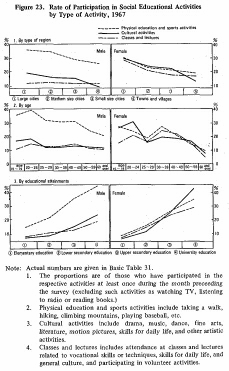| Home > Policy > White Paper, Notice, Announcement > White Paper > EDUCATIONAL STANDARDS IN JAPAN 1971 > CHAPTER |
||

Note: Actual numbers are given in Basic Table 31. Basic Table 31
1.The proportions are of those who have participated in the respective activities at least once during the month preceeding the survey (excluding such activities as watching TV, listening to radio or reading books.)
2. Physical education and sports activities include taking a walk, hiking, climbing mountains, playing baseball, etc.
3. Cultural activities include drama, music, dance, fine arts, literature, motion pictures, skills for daily life, and other artistic activities.
4. Classes and lectures includes attendance at classes and lectures related to vocational skills or techniques, skills for daily life, and general culture, and participating in volunteer activities.
The extent of participation of the people no physical and sports activities, cultural activities, and in classes and lectures is as shown j. Figure 23.The largest proportion of males participated in physical education and sports activities. In the case of females, however, there are no marked differences in the proportions by type of activity. For both males and females, with the exception of mane participation in classes and lectures, the rate or participation is directly proportional to the type of region, the rate becoming higher as the city size increases. In terms of the rate of participation by age, older people tend to participate to a lesser degree, with the exception of females who are in the age group corresponding to infant rearing period. The rate of male participation in cultural activities and physical education and sports activities varies little according to age. As for the rate by educational attainments, both males and females who have completed a higher level of education, participate more in all of the activities. Trends in the number of persons who have attended various classes and lectures encouraged by the national and local governments as social education are as shown in Table 21.

Note: (1) 1965 (2) 1968
In 1969 the number of persons who attended social education classes and lectures conducted by boards of education was 4,650,000, a decrease of 2,400,000from 1963. On the other hand, the number of persons who participated in university extension programs tended to increase, as did the number of these provided with correpondence education authorized by the Ministry of Education, the latter increasing from 228,000 to 7 l0,000.
Social education organizations whose main purpose is the training of their members have a total membership of 35 million as is shown in Table 22. The total number, however, has been decreasing.
Educational broadcasting programs also play an important role in social education. The distribution of programs provided by NHK, by content, is shown in Table 23.

| Back to Top | MEXT HOME |